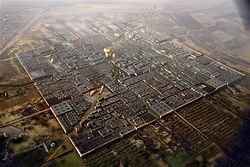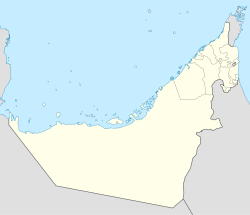- Masdar City
-
Masdar
مصدر— Walled city — Rendering of the future Masdar City from the air Location of Masdar in the UAE Coordinates: 24°25′45″N 54°37′6″E / 24.42917°N 54.61833°ECoordinates: 24°25′45″N 54°37′6″E / 24.42917°N 54.61833°E Country United Arab Emirates Emirate Abu Dhabi Initiated 2006 Government – Chairman Ahmed Ali Al Sayegh – CEO Sultan Ahmed Al Jaber Area – Total 6 km2 (2.3 sq mi) Time zone Arabian Standard Time (UTC+04) Website masdarcity.ae Masdar (Arabic: مصدر, maṣdar, literally source) is a project in Abu Dhabi, in the United Arab Emirates. Its core is a planned city, which is being built by the Abu Dhabi Future Energy Company, a subsidiary of Mubadala Development Company, with the majority of seed capital provided by the government of Abu Dhabi.[1][2] Designed by the British architectural firm Foster and Partners, the city will rely entirely on solar energy and other renewable energy sources, with a sustainable, zero-carbon, zero-waste ecology. The city is being constructed 17 kilometres (11 mi) east-south-east of the city of Abu Dhabi, beside Abu Dhabi International Airport.
Masdar City will host the headquarters of the International Renewable Energy Agency (IRENA).[3][4] The city is designed to be a hub for cleantech companies. Its first tenant is the Masdar Institute of Science and Technology, which has been operating in the city since it moved into its campus in September 2010.[5][6][7]
Contents
Design and intent
The project is headed by the Abu Dhabi Future Energy Company (ADFEC).[8] Initiated in 2006, the project was projected to cost US$22 billion and take some eight years to build, with the first phase scheduled to be completed and habitable in 2009.[9][10][11] Construction began on Masdar City in 2008 and the first six buildings of the city were completed and occupied in October 2010. However, due to the impact of the financial crisis, Phase 1 of the city, the initial 1,000,000 square metres (0.39 sq mi), will be completed in 2015. Final completion is scheduled to occur between 2020 and 2025. The estimated cost of the city has also declined by 10 to 15 percent, putting the development between US$18.7 and 19.8 billion.[12] The city is planned to cover 6 square kilometres (2.3 sq mi) and will be home to 45,000 to 50,000 people and 1,500 businesses, primarily commercial and manufacturing facilities specialising in environmentally friendly products, and more than 60,000 workers are expected to commute to the city daily.[10][13][14] Automobiles will be banned within the city; travel will be accomplished via public mass transit and personal rapid transit systems, with existing road and railways connecting to other locations outside the city.[13][15] The absence of motor vehicles coupled with Masdar's perimeter wall, designed to keep out the hot desert winds, allows for narrow and shaded streets that help funnel cooler breezes across the city.[1]
Masdar City will be the latest of a small number of highly planned, specialized, research and technology-intensive municipalities that incorporate a living environment, similar to Novosibirsk, Russia or Tsukuba Science City, Japan.
Partners in the project through its Clean Tech Fund are Consensus Business Group, Credit Suisse and Siemens Venture Capital.[16] Construction of the first phase of the project is being managed by CH2M HILL. Infrastructure construction for the city will be handled by the Al Jaber Group and design of the central Masdar headquarters building has been awarded to Adrian Smith + Gordon Gill Architecture.[2][11][17]
Renewable resources
Masdar will employ a variety of renewable power resources. Among the first construction projects will be a 40 to 60 megawatt solar power plant, built by the German firm Conergy, which will supply power for all other construction activity.[13][18] This will later be followed by a larger facility, and additional solar panels will be placed on rooftops to provide supplemental solar energy totalling 130 megawatts. Wind farms will be established outside the city's perimeter capable of producing up to 20 megawatts, and the city intends to utilise geothermal energy as well.[13][19] In addition, Masdar plans to host the world's largest hydrogen power plant.[9]
Water management has been planned in an environmentally sound manner as well. A solar-powered desalination plant will be used to provide the city's water needs, which is stated to be 60 percent lower than similarly sized communities.[9] Approximately 80 percent of the water used will be recycled and waste water will be reused "as many times as possible," with this greywater being used for crop irrigation and other purposes.[13][15]
The city will also attempt to reduce waste to zero. Biological waste will be used to create nutrient-rich soil and fertiliser, and some may also be utilised through waste incineration as an additional power source. Industrial waste, such as plastics and metals, will be recycled or re-purposed for other uses.[15]
The exterior wood used throughout the city is Palmwood, a sustainable hardwood-substitute developed by Pacific Green using plantation coconut palms that no longer bear fruit. Palmwood features include the entrance gates, screens and doors.[20]
Reaction
The project is supported by the global conservation charity World Wide Fund for Nature and the sustainability group BioRegional. In response to the project's commitment to zero carbon, zero waste and other environmentally friendly goals, WWF and BioRegional have endorsed Masdar City as an official One Planet Living Community.[21][22]
Some skeptics are concerned that the city will be only symbolic for Abu Dhabi, and that it may become just a luxury development for the wealthy.[9] Nicolai Ouroussoff calls it the ultimate gated community, "the crystallization of another global phenomenon: the growing division of the world into refined, high-end enclaves and vast formless ghettos where issues like sustainability have little immediate relevance."[23]
References
- ^ a b "Masdar plan". The Economist. 4 December 2008. http://www.economist.com/science/tq/displaystory.cfm?story_id=12673433. Retrieved 9 June 2009.
- ^ a b Hope, Bradley; Stanton, Chris (9 February 2009). "Al Jaber secures Masdar deal". The National. http://www.thenational.ae/article/20090209/BUSINESS/779661070. Retrieved 11 June 2009.
- ^ Al Lawati, Abbas (29 June 2009). "UAE to host Irena HQ". Gulfnews.com. http://www.gulfnews.com/nation/Environment/10327093.html. Retrieved 1 July 2009.
- ^ Lawton, Michael (29 June 2009). "Renewable energy agency to call United Arab Emirates home". Deutsche Welle. http://www.dw-world.de/dw/article/0,,4442082,00.html. Retrieved 1 July 2009.
- ^ "Inauguration Of Masdar Institute Campus At Masdar City Underscores Abu Dhabi's Commitment To Build A Knowledge-Based Economy" (Press release). Masdar Institute of Science and Technology. 23 October 2010. https://www.zawya.com/story.cfm/sidZAWYA20101123121153/?relcontent=20110721_15629_93. Retrieved 16 October 2011.
- ^ "Masdar Institute of Science and Technology". MasdarUAE.com. http://www.masdaruae.com/en/Menu/index.aspx?MenuID=48&CatID=26&mnu=Cat. Retrieved 9 June 2009.
- ^ "MIT, Abu Dhabi Future Energy Company sign cooperative agreement". MIT.com News Office. 26 February 2007. http://web.mit.edu/newsoffice/2007/abu-dhabi.html. Retrieved 10 May 2008.
- ^ "The Masdar Initiative: Introduction". MasdarUAE.com. http://www.masdaruae.com/en/Menu/index.aspx?MenuID=42&CatID=12&mnu=Cat. Retrieved 9 June 2009.
- ^ a b c d "Work starts on Gulf 'green city'". BBC News. 10 February 2008. http://news.bbc.co.uk/2/hi/science/nature/7237672.stm. Retrieved 10 May 2008.
- ^ a b "Masdar City: Fast facts". MEED. 17 February 2008. http://www.meed.com/feature/fast_facts/2008/02/masdar_city_fast_facts.html. Retrieved 10 May 2008.
- ^ a b "Bush Previews Abu Dhabi's Planned Carbon Neutral, Car Free City". Environmental News Service. 14 January 2008. http://www.ens-newswire.com/ens/jan2008/2008-01-14-01.asp. Retrieved 10 May 2008.
- ^ Haider, Haseeb (10 October 2010). "Completion of Masdar City pushed back". Khaleej Times. http://khaleejtimes.com/DisplayArticle09.asp?xfile=data/theuae/2010/October/theuae_October256.xml§ion=theuae. Retrieved 4 August 2011.
- ^ a b c d e Dilworth, Dianna (August 2007). "Zero Carbon; Zero Waste in Abu Dhabi". BusinessWeek. http://www.businessweek.com/innovate/content/aug2007/id2007081_901739.htm. Retrieved 10 May 2008.
- ^ Carvalho, Stanley (15 January 2009). "First Solar to help power Masdar, UAE's green city". Reuters UK. http://uk.reuters.com/article/governmentFilingsNews/idUKN1553106120090115?sp=true. Retrieved 9 June 2009.
- ^ a b c Palca, Joe (6 May 2008). "Abu Dhabi Aims to Build First Carbon-Neutral City". National Public Radio. http://www.npr.org/templates/story/story.php?storyId=90042092. Retrieved 10 May 2008.
- ^ "Masdar Partners". MasdarCTF.com. http://www.masdarctf.com/partners.htm. Retrieved 9 June 2009.
- ^ "Masdar HQ to be Located in World's First "Positive Energy" Mixed-Use Building" (Press release). Masdar.ae. 20 February 2008. http://www.masdar.ae/mediaCenter/newsDesc.aspx?fst=mc&nws=17. Retrieved 9 June 2009.
- ^ "Abu Dhabi, Germany's Conergy sign solar power deal". Reuters UK. 2 July 2007. http://uk.reuters.com/article/oilRpt/idUKL0232136520070702?sp=true. Retrieved 10 May 2008.
- ^ Hamner, Susanna (6 August 2007). "World's first carbon-free city". Business 2.0 via CNNMoney.com. http://money.cnn.com/magazines/business2/business2_archive/2007/08/01/100138819/index.htm. Retrieved 10 May 2008.
- ^ Laylin, Tafline (10 February 2011). "Pacific Green Inaugurates Masdar City's Sustainable Palm Gates". Green Prophet. http://www.greenprophet.com/2011/02/pacific-green-masdar-gates/. Retrieved 4 August 2011.
- ^ "WWF, Abu Dhabi unveil plan for world’s first carbon-neutral, waste-free, car-free city" (Press release). World Wildlife Fund via Panda.org. 13 January 2008. http://www.panda.org/wwf_news/press_releases/?121320/WWF-Abu-Dhabi-unveil-plan-for-worlds-first-carbon-neutral-waste-free-car-free-city. Retrieved 9 June 2009.
- ^ "One Planet Living: United Arab Emirates Endorsed Community - Masdar City" (Press release). BioRegional.com. 8 January 2008. http://www.bioregional.com/oneplanetliving/uae/masdar. Retrieved 23 April 2008.
- ^ Ouroussoff, Nicholai (25 September 2010). "In Arabian Desert, a Sustainable City Rises". The New York Times. http://www.nytimes.com/2010/09/26/arts/design/26masdar.html. Retrieved 26 September 2010.
External links
Developments in Abu Dhabi Proposed or under constructionMuseums Louvre Abu Dhabi · Guggenheim Abu Dhabi · Abu Dhabi Performing Arts Center · Abu Dhabi Maritime Museum · Zayed MuseumShopping centres Yas MallTransport Other projects Al Lulu Island · Al Raha · Al Reem Island · Central Market Project · Marina Bay · Masdar City · Saadiyat Island · Yas IslandEmirate of Abu Dhabi Cities and areas Abu al Abyad · Abu Dhabi · Al Ain · Al-Aryam Island · Al Mushrif · Bahrani Island · Dalma · Habshan · Khalifa City · Liwa Oasis · Marawah · Mussafah · Port Zayed · Ruwais · Sila · Sir Bani Yas · Yas IslandGovernment Culture Louvre Abu Dhabi · Guggenheim Abu Dhabi · Cultural Foundation · Qasr al-Hosn · Abu Dhabi Performing Arts Center · Abu Dhabi Maritime Museum · Zayed Museum · Al Ain National Museum · Sheikh Zayed Palace MuseumTransport Development projects Lulu Island · Al Raha · Al Reem Island · Central Market Project · Marina Bay · Masdar City · Saadiyat IslandMiscellaneous Sister Cities Categories:- 2006 establishments
- Development projects in Abu Dhabi
- Planned cities in the United Arab Emirates
- Norman Foster buildings
- Proposed populated places
Wikimedia Foundation. 2010.


